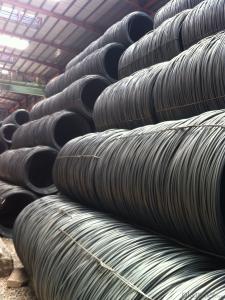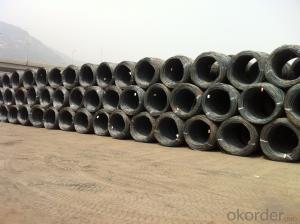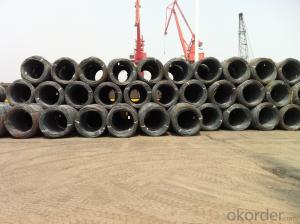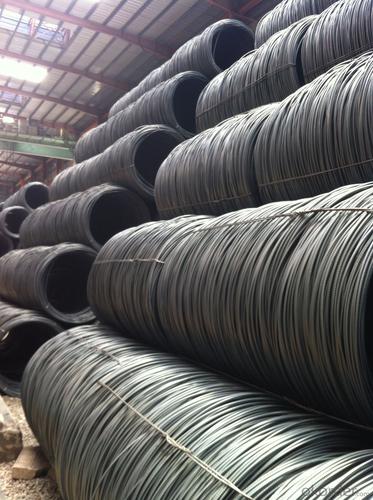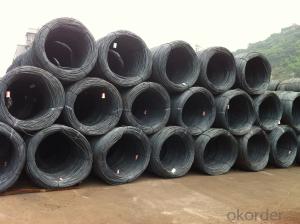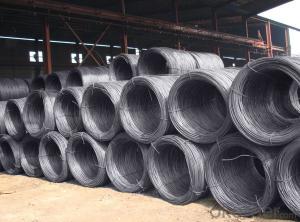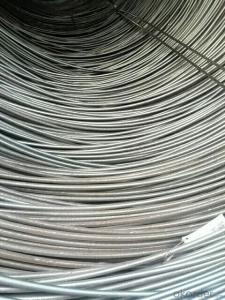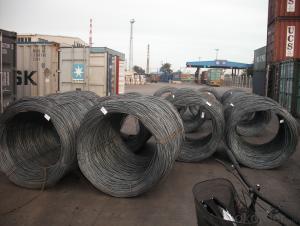Hot Rolled Steel Wire Rods with Best Price in Grade SAE1006-1018
- Loading Port:
- Tianjin
- Payment Terms:
- TT OR LC
- Min Order Qty:
- 25 m.t
- Supply Capability:
- 10000 m.t/month
OKorder Service Pledge
OKorder Financial Service
You Might Also Like
OKorder is offering wire rods at great prices with worldwide shipping. Our supplier is a world-class manufacturer of steel, with our products utilized the world over. OKorder annually supplies products to European, North American and Asian markets. We provide quotations within 24 hours of receiving an inquiry and guarantee competitive prices.
Product Applications:
After hot-rolled the products shaped into coil and delivery as finished product, including round, square,rectangular, hexagonal and so on. Since most of the products are round, it is generally called wire rod. Carbon steel wire rod is widely used in construction and manufacturing. Carbon steel wire rod is mainly used for reinforcement of reinforced concrete and welded structure or reprocessed (roberts , nail, etc.) materials, especially used to produce wire drawing, welding electrode, nails, spring, electronic, precise machinery parts and so on.
Product Advantages:
OKorder's Wire rods are durable, strong, and resist corrosion.
Main Product Features:
· Premium quality
· Prompt delivery & seaworthy packing (30 days after receiving deposit)
· Corrosion resistance
· Can be recycled and reused
· Mill test certification
· Professional Service
· Competitive pricing
Product Specifications:
Manufacture: Hot rolled
Grade: SAE1006-SAE1018
Certificates: ISO, SGS, BV, CIQ
Packaging: Export packing, nude packing, in coils
Grade | Chemical Composition (%) | |||||
C | Mn | S | P | Si | B | |
SAE1008B | 0.10max | 0.32max | 0.045max | 0.040max | 0.30max | 0.0008min |
Mechanical properties | ||||||
Yield strength(N/mm2) | Tensile strength(N/mm2) | Elongation (%) | ||||
≥195 | 350-380 | ≥32 | ||||
FAQ:
Q1: Why buy Materials & Equipment from OKorder.com?
A1: All products offered byOKorder.com are carefully selected from China's most reliable manufacturing enterprises. Through its ISO certifications, OKorder.com adheres to the highest standards and a commitment to supply chain safety and customer satisfaction.
Q2: How do we guarantee the quality of our products?
A2: We have established an advanced quality management system which conducts strict quality tests at every step, from raw materials to the final product. At the same time, we provide extensive follow-up service assurances as required.
Q3: How soon can we receive the product after purchase?
A3: Within three days of placing an order, we will begin production. The specific shipping date is dependent upon international and government factors, but is typically 7 to 10 workdays.
Images:
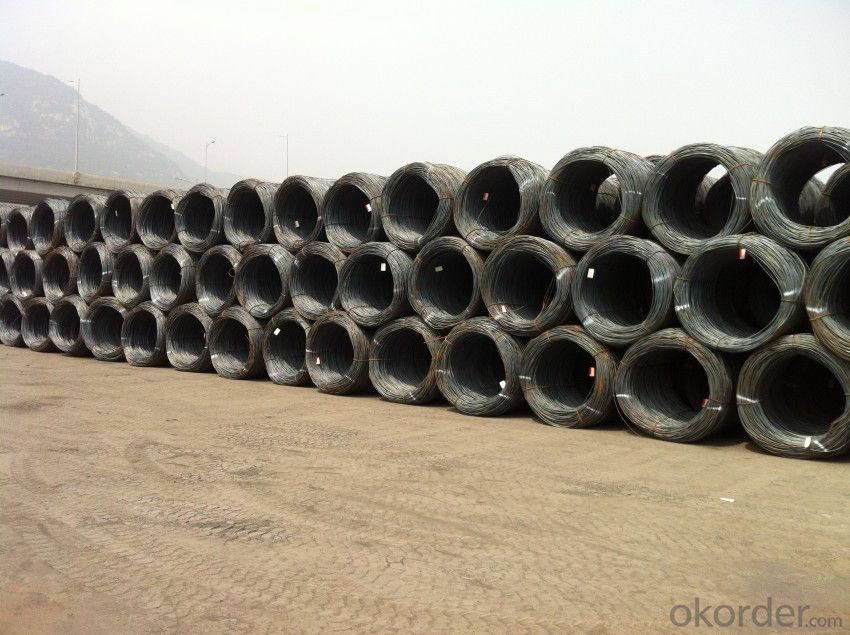
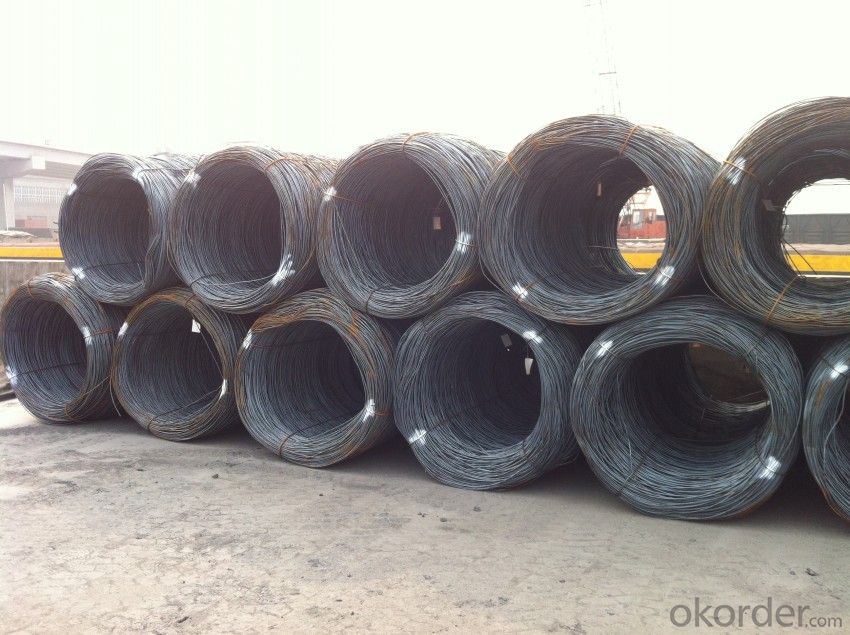
- Q: How are steel wire rods used in the production of wire springs?
- Wire springs rely heavily on steel wire rods, which are melted and shaped into cylindrical forms through rolling. The resulting rods are then drawn through dies to decrease their diameter and increase their length, imparting strength and flexibility. This process ensures the suitability of the wire rods for spring usage. After the drawing process, the steel wire rods are commonly coiled onto large spools or reels. These coiled wires are then fed into machines that manufacture springs. The wire is cut to the desired length and shaped into different spring forms, such as helical coils or conical shapes. The inherent strength and elasticity of steel wire rods make them highly suitable for wire springs. These springs find extensive applications in various industries, including automotive suspensions, furniture, industrial machinery, and household appliances. The steel wire rods provide the necessary tensile strength and resilience to endure the forces and stresses experienced in these applications. To sum up, steel wire rods play a crucial role in the production of wire springs, providing the strength, flexibility, and resilience required for effective functioning in diverse industries and applications.
- Q: What are the different types of steel wire rod wire drawing lubricants?
- There are various types of steel wire rod wire drawing lubricants, including dry lubricants, oil-based lubricants, and water-based lubricants. Dry lubricants are typically a mixture of graphite and other solid lubricants, which reduce friction during the wire drawing process. Oil-based lubricants are formulated with mineral or synthetic oils, providing excellent lubricity and reducing heat generation. Water-based lubricants are composed of water and additives like emulsifiers, rust inhibitors, and lubricating agents, offering good cooling and lubrication properties during wire drawing.
- Q: What are the main uses of steel wire rod?
- Steel wire rod has a wide range of uses across various industries. It is primarily used for manufacturing wire products such as nails, screws, springs, and fencing. Additionally, it is used in the construction sector for reinforcing concrete structures and in the automotive industry for making tire cords and springs. Steel wire rod also finds application in the manufacturing of electrical cables, wire mesh, and welding electrodes.
- Q: How is steel wire rod used in the manufacturing of wire for reinforced concrete structures?
- Steel wire rod is crucial in the production of wire used for reinforcing concrete structures. It acts as the primary raw material for manufacturing strong and long-lasting wires that reinforce concrete structures. To begin with, the steel wire rod undergoes a series of processes to convert it into wire suitable for concrete reinforcement. These processes involve cleaning, descaling, and surface treatment to eliminate impurities and enhance its strength and resistance to corrosion. Afterward, the wire rod is drawn into the desired diameter, typically ranging from 5mm to 12mm, through a series of die reductions in order to achieve the necessary strength and flexibility. Once the wire is formed, it is utilized to create reinforcing mesh or rebar. Reinforcing mesh consists of steel wires arranged in a grid pattern to provide consistent and uniform reinforcement throughout the concrete structure. On the other hand, rebar is a long, straight steel rod that is usually embedded within the concrete to provide additional strength and structural integrity. During the manufacturing process, the steel wire rod is often further treated to enhance its bond with the concrete. This treatment, known as ribbing or deforming, involves adding ridges or deformations to the wire's surface to increase its surface area and create a better mechanical grip with the concrete. This ribbing process improves the bond between the wire and the surrounding concrete, ensuring effective load transfer and preventing slippage between the two materials. The steel wire rod used in the production of wire for reinforced concrete structures must meet specific mechanical and chemical properties. These properties include high tensile strength, excellent ductility, and corrosion resistance, as the wire will be subjected to various stresses and environmental conditions once it is embedded within the concrete. In conclusion, steel wire rod plays a crucial role in the manufacturing of wire for reinforced concrete structures. It undergoes various processes to produce high-strength and corrosion-resistant wire suitable for reinforcing concrete. The resulting wire is used to create reinforcing mesh or rebar, which provides additional strength, durability, and structural integrity to concrete structures.
- Q: What are the different types of wire mesh for sieving made from steel wire rod?
- There are several different types of wire mesh for sieving that are made from steel wire rod. These types include: 1. Plain weave wire mesh: This is the most common type of wire mesh used for sieving. It is made by weaving the steel wire rods together in an over-and-under pattern, creating a square or rectangular mesh structure. Plain weave wire mesh is known for its simplicity and versatility. 2. Twill weave wire mesh: Twill weave wire mesh is similar to plain weave, but the wires are interlaced in a diagonal pattern, creating a tighter mesh structure. This type of wire mesh is often used for fine sieving applications where a higher level of precision is required. 3. Dutch weave wire mesh: Dutch weave wire mesh is made by weaving the wires in an over-and-under pattern, but with different wire diameters for the warp and weft wires. This creates a mesh with smaller openings in one direction, making it ideal for applications where fine particles need to be separated. 4. Welded wire mesh: Welded wire mesh is made by welding the intersecting points of the steel wires together, creating a strong and durable mesh structure. This type of wire mesh is commonly used for heavy-duty sieving applications, such as in construction or industrial settings. 5. Expanded metal mesh: Expanded metal mesh is made by cutting and stretching a flat sheet of steel, creating a mesh with diamond-shaped openings. This type of wire mesh is known for its strength and rigidity, making it suitable for sieving applications that require high impact resistance. Overall, the different types of wire mesh for sieving made from steel wire rod offer a range of options to suit various sieving needs, from basic to more specialized applications. The choice of wire mesh will depend on factors such as the size of the particles being sieved, the desired level of precision, and the intended use of the sieved material.
- Q: How is steel wire rod used in the manufacturing of wire trellis?
- Steel wire rod is used in the manufacturing of wire trellis as it serves as the primary material for creating the trellis framework. The wire rod is typically shaped into various configurations, such as grids or panels, and welded together to form a sturdy and durable structure. Additionally, the wire rod can be coated or galvanized to enhance its resistance to corrosion and ensure longevity.
- Q: What are the different types of heat treatment processes for steel wire rod?
- There are several different types of heat treatment processes for steel wire rod, including annealing, normalizing, quenching and tempering. Annealing involves heating the steel to a specific temperature and then slowly cooling it to make it softer and more ductile. Normalizing is similar to annealing, but the cooling process is done in still air instead of slowly. Quenching involves rapidly cooling the steel by immersing it in a liquid, such as oil or water, to make it harder and stronger. Tempering is a process that follows quenching, where the steel is reheated to a lower temperature to reduce its brittleness and improve its toughness.
- Q: What are the different types of steel wire rod finishes for improved impact resistance?
- There are several types of steel wire rod finishes that can improve impact resistance. Some common finishes include galvanized, epoxy coated, and zinc-coated finishes. These finishes provide a protective layer that enhances the durability and strength of the wire rod, making it more resistant to impacts and potential damage.
- Q: What are the different surface defects that can affect the performance of steel wire rod?
- Some of the different surface defects that can affect the performance of steel wire rod include cracks, pits, scale, scratches, and decarburization. These defects can weaken the structural integrity of the wire rod, reduce its load-bearing capacity, and increase the likelihood of failure during use.
- Q: How is steel wire rod used in the manufacturing of wire mesh for concrete reinforcement?
- Steel wire rod is an essential component in the manufacturing of wire mesh for concrete reinforcement. Wire mesh is a grid-like structure made from interconnected steel wires, and it serves to enhance the strength and durability of concrete structures. Steel wire rod is used as the primary material for producing the wires that form the mesh. The rod is typically made from carbon steel and undergoes a series of processes to transform it into the desired wire diameter and tensile strength. These processes include hot rolling, pickling, and drawing. Once the steel wire rod has been transformed into wire, it is then formed into a mesh pattern through a weaving or welding process. The mesh pattern can vary, with common options being square or rectangular openings. The spacing between the wires is usually determined based on the specific requirements of the concrete project. During the manufacturing process, the wire mesh is carefully designed to provide reinforcement to concrete structures. When concrete is poured, the wire mesh is placed within it, creating a network of interconnected wires that help distribute the load evenly. This reinforcement significantly improves the concrete's resistance to cracking and breaking under stress, such as from heavy loads or temperature changes. Additionally, wire mesh also helps to control shrinkage and prevent the formation of large cracks in the concrete. By restricting the movement of individual concrete elements, the mesh ensures that any cracks that do form are smaller and more manageable. In summary, steel wire rod plays a crucial role in the manufacturing of wire mesh for concrete reinforcement. It is transformed into wire, which is then woven or welded into a mesh pattern. This mesh is placed within concrete structures to enhance their strength, durability, and resistance to cracking and breaking.
Send your message to us
Hot Rolled Steel Wire Rods with Best Price in Grade SAE1006-1018
- Loading Port:
- Tianjin
- Payment Terms:
- TT OR LC
- Min Order Qty:
- 25 m.t
- Supply Capability:
- 10000 m.t/month
OKorder Service Pledge
OKorder Financial Service
Similar products
Hot products
Hot Searches
Related keywords
